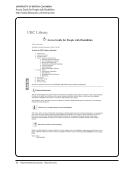SPEC Kit 321: Services for Users with Disabilities · 47
We use a subscription service that makes all of our web pages accessible in a text-only format. So this is something we
don’t do, but this outside service does it for us.
Web developer tests this for us.
Website compliance.
Work to make sure web products meet section 508 standards.
Additional Comments
22. Please enter any additional information that may assist the author’s understanding of your library’s
services for users with disabilities. N=15
All staff and students with disabilities receive direct assistance from the campus Specialized Support and Disability
Services office. The office takes charge of student requests for library assistance and will direct them to the library as
need be with appropriate technological assistance. The Libraries receive very few requests for services from disabled
patrons who have not first sought assistance with the SSDS office. The office has the expertise and the technology
available to assist and train students. The Humanities and Social Sciences Library has one carrel room reserved for
patrons with disabilities, but the SSDS office has the key to the room.
As library coordinator for these services, I have a close working relationship with the technology specialist, counselors
and director of the campus Disabilities Resource Center. They are generous with their time and expertise.
In Ontario, we now have the Ontarians with Disabilities Act, which lays out several regulations (including Customer
Service, Information &Communications), which we must follow regarding accessibility. We are in the early stages of this
legislation, which applies across campus. What we do regarding accessibility is laid out on our website: http://www.lib.
uwo.ca/accessibility.
Key service providers: Crane Resource Centre and Library: principal resource for people who are blind, visually impaired,
or print-handicapped. Technical resources include an 8 studio book recording and duplicating facility, dedicated
computers to convert print to synthesized speech, adapted workstations with voice synthesis and image-enlarging,
computerized Braille transcription facility, a talking on-line public catalogue, TV magnifiers, and more. The Centre is not
a UBC branch library, but its collection may be accessed through the online catalogue. The Crane Resource Centre and
Library is connected to the Disability Resource Centre, which is now a part of Access &Diversity. The Disability Resource
Centre started in 1991. The Disability Resource Centre became part of Access &Diversity in 2003.
The UBC Library provides Enhanced Library services to students who qualify for these services. Services include
catalogue assistance, book/journal retrieval, photocopying, browsing assistance, wayfinding (apply at the Circulation
Desk).
The first step in the process of providing services is for the student to register with the Access &Diversity office.
In summary: the three service points are the Access &Diversity office, Student Development and Services Crane
Resource Centre &Library and/or Disability Centre UBC Library Enhanced Services (primary service point =Circulation
in each branch library or Borrower Services -Koerner Library).
The AVP Equity reports to the Vice President Academic.
We use a subscription service that makes all of our web pages accessible in a text-only format. So this is something we
don’t do, but this outside service does it for us.
Web developer tests this for us.
Website compliance.
Work to make sure web products meet section 508 standards.
Additional Comments
22. Please enter any additional information that may assist the author’s understanding of your library’s
services for users with disabilities. N=15
All staff and students with disabilities receive direct assistance from the campus Specialized Support and Disability
Services office. The office takes charge of student requests for library assistance and will direct them to the library as
need be with appropriate technological assistance. The Libraries receive very few requests for services from disabled
patrons who have not first sought assistance with the SSDS office. The office has the expertise and the technology
available to assist and train students. The Humanities and Social Sciences Library has one carrel room reserved for
patrons with disabilities, but the SSDS office has the key to the room.
As library coordinator for these services, I have a close working relationship with the technology specialist, counselors
and director of the campus Disabilities Resource Center. They are generous with their time and expertise.
In Ontario, we now have the Ontarians with Disabilities Act, which lays out several regulations (including Customer
Service, Information &Communications), which we must follow regarding accessibility. We are in the early stages of this
legislation, which applies across campus. What we do regarding accessibility is laid out on our website: http://www.lib.
uwo.ca/accessibility.
Key service providers: Crane Resource Centre and Library: principal resource for people who are blind, visually impaired,
or print-handicapped. Technical resources include an 8 studio book recording and duplicating facility, dedicated
computers to convert print to synthesized speech, adapted workstations with voice synthesis and image-enlarging,
computerized Braille transcription facility, a talking on-line public catalogue, TV magnifiers, and more. The Centre is not
a UBC branch library, but its collection may be accessed through the online catalogue. The Crane Resource Centre and
Library is connected to the Disability Resource Centre, which is now a part of Access &Diversity. The Disability Resource
Centre started in 1991. The Disability Resource Centre became part of Access &Diversity in 2003.
The UBC Library provides Enhanced Library services to students who qualify for these services. Services include
catalogue assistance, book/journal retrieval, photocopying, browsing assistance, wayfinding (apply at the Circulation
Desk).
The first step in the process of providing services is for the student to register with the Access &Diversity office.
In summary: the three service points are the Access &Diversity office, Student Development and Services Crane
Resource Centre &Library and/or Disability Centre UBC Library Enhanced Services (primary service point =Circulation
in each branch library or Borrower Services -Koerner Library).
The AVP Equity reports to the Vice President Academic.




































































































































































































